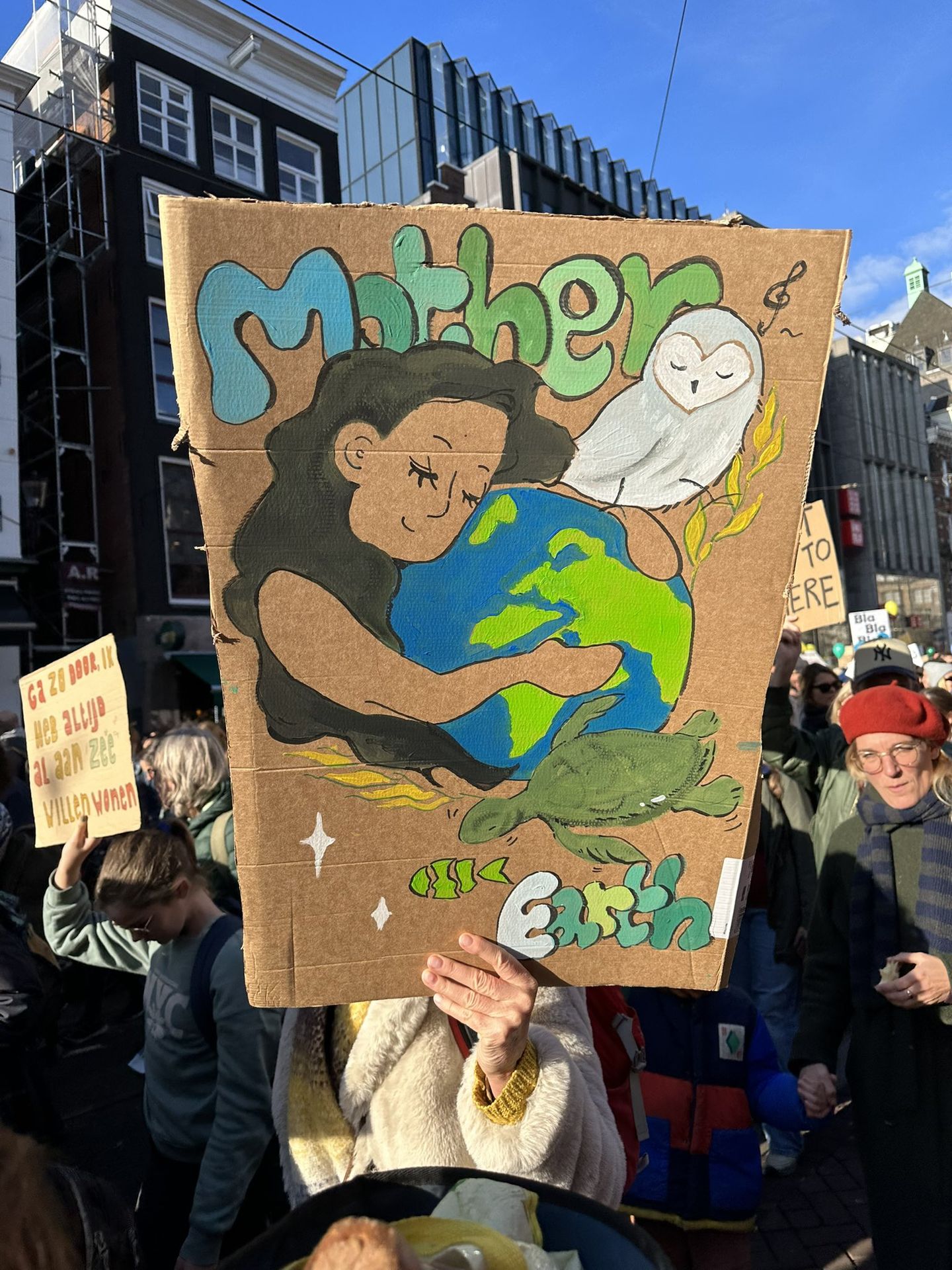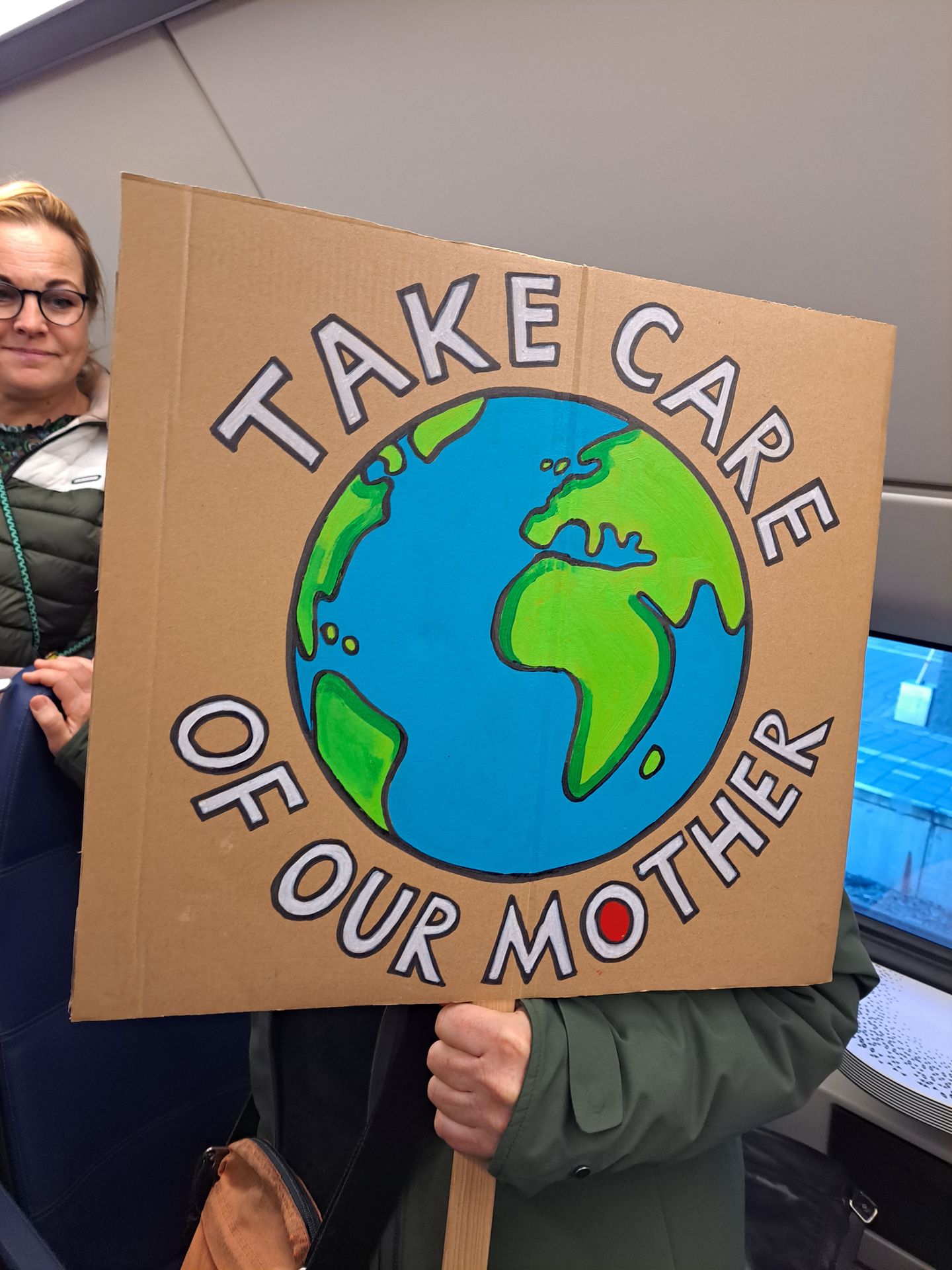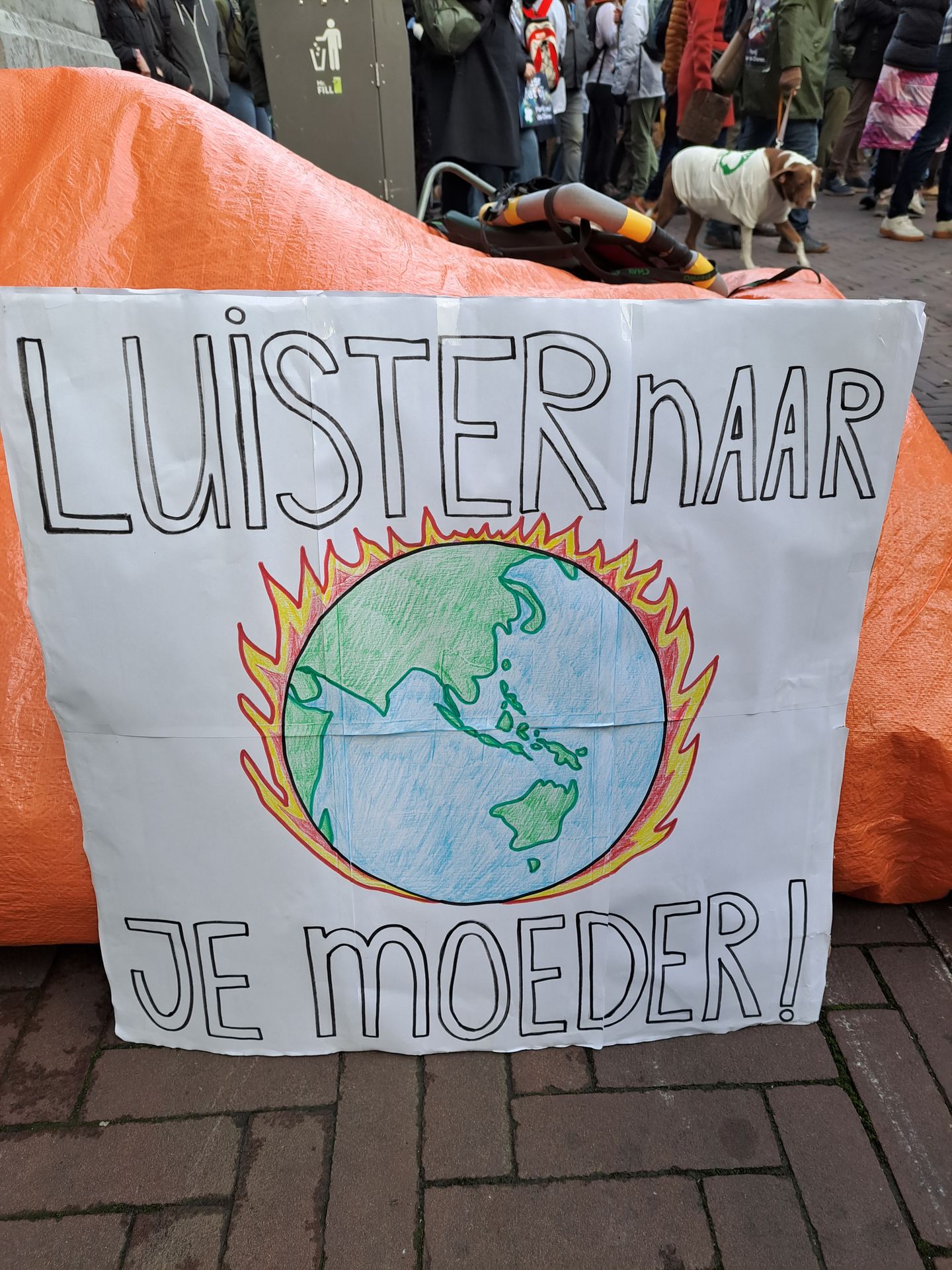Guest blog by Nikki Apeldoorn
‘Love your Mother.’ ‘Listen to your Mother.’ ‘Take care of our Mother.’ Just a few examples of the gendered protest signs from the Climate March that took place on November 23, 2023 in Amsterdam. Such a gendering of the earth in climate discourse is widespread and generally accepted without question. This ancient metaphor of Mother Earth, has come to be seen by some as an “endlessly fruitful antidote to patriarchal logic” and by others as “the phallic mother who remains a tool of patriarchal discourses” (McCredden 2022, 130). As an ecofeminist theologian my positionality is ambivalent. The metaphor of Mother Earth has spiritual and indigenous roots and I feel a very strong attraction to it, but I am also very suspicious of the ways in which it is used in contemporary climate discourse.

Figure 1: https://twitter.com/ecotist/status/1723794725335978271/photo/4
(accessed on 27 June 2024)
Ecofeminism
The relationship between gender and environmentalism has been most fully explored in the field of ecofeminism. Ecofeminist scholars encourage us to examine the patriarchal dimensions of climate discourse. Although much of this work is very theoretical and diverse, they expose and invalidate patriarchal bases and biases’. Where some argue that the gendering of the earth as female might have practical or strategic value and can provide a means of identification for humans with nature and a source of empowerment for women (Vandana Shiva, Starhawk, Mary Vidya Porselvi), others warn us that these strategies are sometimes counterproductive and tend to reinforce what they try to combat, by perpetuating oppositional thinking and oppression of both women and the earth (Greta Gaard, Chaia Heller, Sherilyn Macgregor, Catriona Sandilands).
What ecofeminists generally agree on is that there is a connection between the ecological crisis and the social justice crisis. The oppression of women and the oppression of the earth are both symptoms of a patriarchal order (Elvey, 2022). The “anthropos” in the anthropocentrism that is often critiqued is not just any human, but a predominantly white, European and male human being. A critical gender perspective is therefore important in the field of ecology and environmentalism.

Figure 2: Photo made by Deborah de Koning, 12 november 2023, Amsterdam.
Motherhood environmentalism
At first sight it appears that the Mother Earth metaphor in the Climate March is (strategically) used to encourage certain environmental behavior and represent a loving and caring relationship between humans and the earth. As such it seems to subvert a behavior of dominance and mastery and a hierarchy that locates humans above nature. It could even advocate to revalue both women and the earth with one single metaphor as some kind of post-secular sacred.
It is important to realise that the most dominant gendered representations of the earth are almost exclusively female. Earth is not just personified or anthropomorphized, it is gendered and it is not just gendered, it is also attributed a heterosexual, naturalized role of mother. As a ecofeminist theologian Primavesi (1990, 34) explains how, Mother Earth “gathers other constellations of metaphors around it such as womb, nurse, virgin, seed, fertility and barrenness which imply an active partner, man” that the woman and the earth are dependent on. Such a rhetoric naturalizes dependency, hierarchy and heterosexuality. This compulsory heterosexuality is also criticised in Greta Gaard’s argument (inspired by Adrienne Rich) that when nature is feminized and therefore sexualized, culture is masculinized and the human-nature relationship becomes a heterosexual one (Gaard 1993, 204). Gaard refers here to the dominant patriarchal language of reproduction, that is assigned to both women and the earth.
A critical gender perspective challenges us to take a closer look at the role and meaning attributed to mothers in the patriarchal dualist paradigm of modern culture. The ideal mother in this culture is the one that nurtures us and provides for us abundantly, asking nothing in return. According to ecofeminist theologian Elizabeth Dodson Gray (1979) the last thing the environmental movement should do is encourage us to think of the environment in these terms, as our ecological crisis is partly caused by exhausting resources that we think are endless. The use of eco-maternalistic rhetoric in climate discourse thus naturalises and normalises gendered stereotypes of feminised bodies. Both mothers and the earth are identified with, and limited to, the inferior androcentric role of providing and nurturing.
Scholar in environmental humanities Caitriona Sandilands (1997) is very critical of this ‘motherhood environmentalism.’ “This articulation of ecology with neo-conservative discourses on the family is truly frightening in its implications for women. It is a naturalized morality tale of private women embodying particularistic, nuclear-family-oriented, antifeminist, heterosexist, and ultimately apolitical interests” (Sandilands 1999, 13). So even when the language around the mother earth metaphor is not necessarily hierarchical, as we see in some of the protest signs, the mother earth metaphor itself is. We have to continue to read that what is not written, that what is not said: Love your mother, so it can provide for us abundantly. Take care of your mother, so it can provide for us abundantly. Listen to your mother, so it can provide for us abundantly.

Figure 2: Photo made by Deborah de Koning, 12 november 2023, Amsterdam.
Conclusion
The eco-sociological crisis needs us to promote constructive human-earth relations, but representing the earth as female and the human as male reinforces hegemonic patriarchal and heteronormative structures and a logic of dominance and control. This dualist logic, that is deeply imbedded in the foundation of modern society, has helped pave the way to the ecological crisis and prevents us from addressing it in an effective manner. Feminizing the earth is part of this dualist paradigm and although it can be subversive of some patriarchal structures within this paradigm, it still reinforces the same problematic paradigm.
A critical gender and ecological perspective requires the separate consideration of women and earth, but a connected solution to their twinned oppression. Mother Earth will not be the one to guide the exodus out of the destruction of the Anthropocene. As a metaphor her subversive power in modern culture is limited and as a feminist or ecological concept she is going against her own interests. Earth is just as much Mother as God is Father and after decades of (eco)feminist theologians and lay people questioning the gendering of God, it is time to question the gendering of the Earth as well.
The way we conceive of earth and portray earth through our language has serious implications for our relationship with the natural world and with each other. If we want to depatriarchalize these images and bring in a critical gender perspective in the field of ecology, ecotheology and the environmental movement we have to create new metaphors that challenge the naturalisation of intersecting oppressive structures and represent a queer and reciprocal, interdependent relation between humans and earth. These metaphors can be anthropomorph, but should not be androcentric or anthropocentric. One example could be the metaphor of “Lover Earth” that Stephens and Sprinkle (2021) develop in their art.
It is however important to remember that the perfect metaphor does not exist and we should not simply replace one metaphor for another, but embrace a diversity of non- or maybe even poly-gendered images. “If ecofeminism is to live up to its potential of bringing together gender and nature in a politically interesting, subversive, and/or transformative manner, then its nascent cyborgs and queers need to get out of mother earth's closet and play more visibly in the gap between life and construction” (Sandilands, 1997).
Literature
Elvey, Anne. “Ecological Feminist Hermeneutics” in The Oxford Handbook of the Bible and Ecology, edited by Hilary Marlow and Mark Harris. Oxford University Press, 2022.
Gaard, Greta. Ecofeminism. Temple University Press, 1993.
Gray, Elizabeth Dodson. Green Paradise Lost, 1979. https://ci.nii.ac.jp/ncid/BA19850751.
McCredden, Lyn. “Historicising the Metaphor of Mother Earth.” Www.Academia.Edu, February 20, 2022. https://www.academia.edu/71994420/Historicising_the_Metaphor_of_Mother_Earth.
Primavesi, Anne. From Apocalypse to Genesis: Ecology, Feminism, and Christianity. Augsburg Fortress Publishing, 1990.
Sandilands, Catriona. “Mother Earth, The Cyborg, and the Queer: EcoFeminism and (MOre) Questions of Identity.” NWSA Journal 9, no. 3 (October 1, 1997): 18–40. https://doi.org/10.2979/nws.1997.9.3.18.
Sandilands, Catriona. The Good-Natured Feminist: Ecofeminism and the Quest for Democracy, 1999, http://ci.nii.ac.jp/ncid/BA49103431.
Sprinkle, Annie, Beth Stephens, Jennie Klein, and Linda Montano. Assuming the Ecosexual Position: The Earth as Lover. U of Minnesota Press, 2021.


'Love your Mother': Gendered Protest Signs from the Dutch Climate March 2023